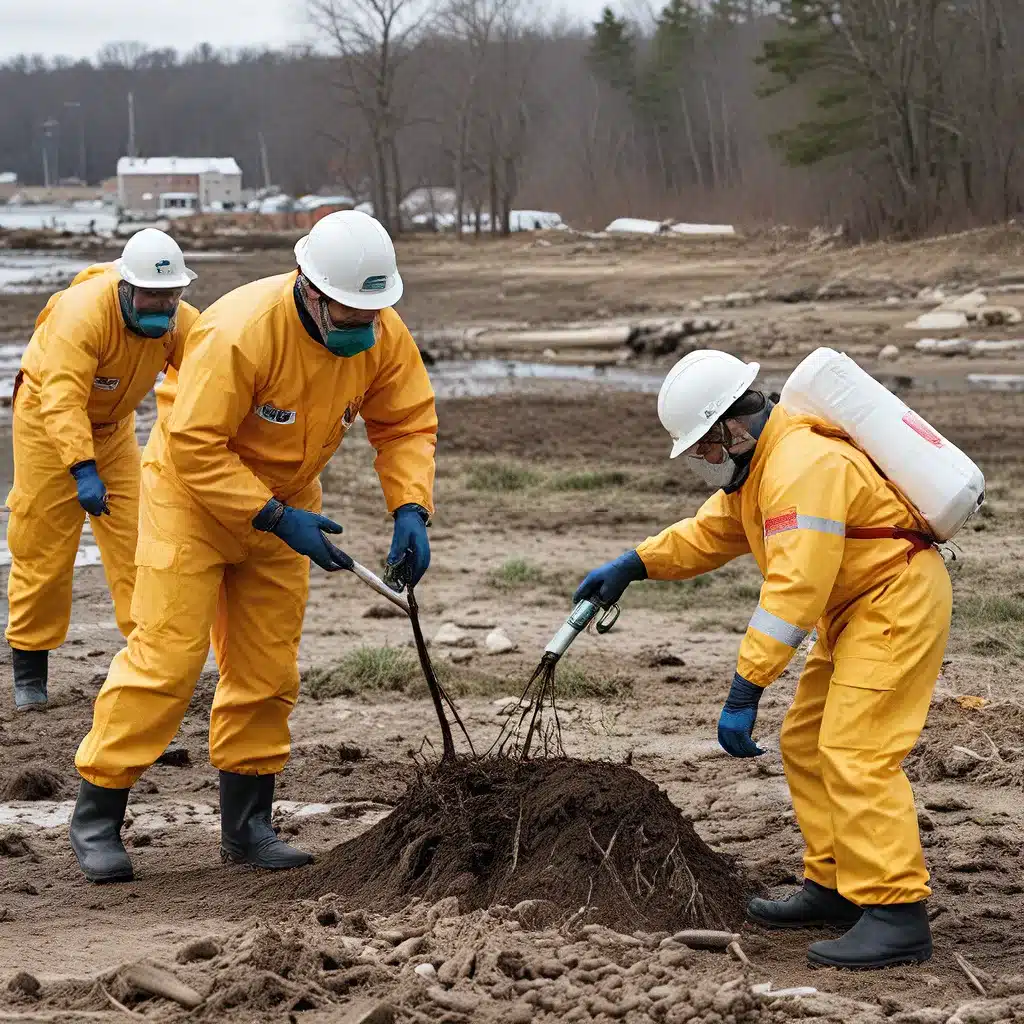
A Delicate Dance with Nature
Picture this: You’re on a pristine beach, the waves gently lapping at the shoreline, seagulls soaring overhead. It’s the perfect picture of tranquility – until disaster strikes. Suddenly, the serene scene is marred by an ominous black slick, the telltale sign of an oil spill. Or perhaps a chemical leak has contaminated the local waterways, putting wildlife and human health at risk.
As an environmental enthusiast, I’ve seen firsthand the devastating impact that oil, chemical, and other hazardous spills can have on our delicate ecosystems. It’s a harsh reminder that the balance of nature is a fragile thing, easily disrupted by human activity. But the good news? There are dedicated teams of experts working tirelessly to restore that balance when crisis strikes.
Navigating the Murky Waters of Spill Response
When disaster strikes, the first responders on the scene are often faced with a daunting challenge: How do we contain the damage and prevent it from spreading? This is where the unsung heroes of environmental cleanup step in – the hazardous materials (HAZMAT) teams.
These highly trained professionals are the front line of defense against environmental catastrophes. Equipped with specialized gear and cutting-edge technology, they descend upon the affected area, ready to tackle the spill head-on. It’s a race against time, as they work to pinpoint the source, assess the extent of the contamination, and deploy the appropriate containment and cleanup methods.
According to the National Oceanic and Atmospheric Administration (NOAA), the release of oil and chemicals into our coastal waterways is a major problem – not just for the environment, but for the communities that depend on it. Imagine a bustling seaside town, its economy fueled by fishing, tourism, and recreational activities. A spill could devastate that delicate ecosystem, shutting down beaches, disrupting commerce, and leaving the locals high and dry.
Unsung Heroes: The HAZMAT Teams
But HAZMAT teams aren’t just concerned with the immediate cleanup. They also play a crucial role in assessing and restoring the long-term damage to the environment. Using advanced modeling and monitoring techniques, they can predict the movement and impact of the contaminants, helping to guide the cleanup efforts and minimize the harm to sensitive habitats and wildlife.
It’s a complex and often thankless job, but the HAZMAT professionals I’ve worked with are a dedicated bunch. They’re part scientist, part detective, always on the lookout for the next clue that can help them turn the tide on environmental disaster.
Take for example the team that responded to the BP Deepwater Horizon oil spill in the Gulf of Mexico. They were faced with a mammoth task – containing the largest offshore oil spill in US history. But they didn’t back down. Instead, they leveraged cutting-edge technology, like underwater gliders and high-frequency radar, to track the movement of the oil and guide the cleanup efforts.
Restoring the Delicate Balance
Of course, the work doesn’t end when the bulk of the spill is cleaned up. That’s just the beginning. The real challenge lies in restoring the delicate balance of the affected ecosystem, ensuring that the natural resources and the communities that depend on them can recover and thrive once more.
NOAA’s Damage Assessment, Remediation, and Restoration Program plays a critical role in this process. These teams of scientists, economists, and restoration experts work tirelessly to assess the extent of the damage and develop a comprehensive plan to rehabilitate the affected areas.
It’s a meticulous process, involving everything from studying the impacts on local wildlife and habitats to conducting economic analyses to determine the true cost of the spill. But it’s a necessary one, because the effects of environmental contamination can linger for decades.
A Balancing Act: Protecting the Environment and Supporting Communities
As I dig deeper into this topic, I’m struck by the delicate balance that HAZMAT teams and environmental restoration experts must strike. On the one hand, they’re tasked with protecting the natural world, ensuring that fragile ecosystems and vulnerable species are given a fighting chance to recover. But on the other, they also have to consider the needs of the human communities that rely on these resources for their livelihoods and way of life.
It’s a tricky tightrope to walk, but the dedicated professionals I’ve met are up to the challenge. They understand that environmental restoration is not just about cleaning up the mess – it’s about restoring the balance, finding innovative solutions that benefit both nature and the people who depend on it.
Inland Waters Inc., for example, is a company that specializes in providing comprehensive environmental cleanup and restoration services. Their teams of HAZMAT experts and restoration scientists work tirelessly to not only contain the immediate damage of a spill, but also to develop long-term strategies for reviving affected ecosystems and supporting the communities that rely on them.
A Glimmer of Hope Amidst the Chaos
As daunting as the task may seem, I find myself feeling cautiously optimistic. Because for every devastating spill, there are the unsung heroes – the HAZMAT teams, the restoration experts, the scientists – who are fighting to restore the balance, to heal the wounds that we’ve inflicted on our planet.
Sure, it’s a constant battle, a delicate dance between human activity and the natural world. But with the right expertise, the right technology, and the right commitment to environmental stewardship, I believe we can tip the scales back in nature’s favor.
It won’t be easy, and there will undoubtedly be more crises to come. But as I witness the tireless efforts of these environmental champions, I can’t help but feel a sense of hope. Because when the dust settles and the cleanup is done, the real work begins – the work of restoring balance, of healing the land and the waters that sustain us all.
And that, my friends, is a cause worth fighting for.


